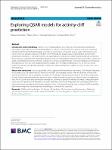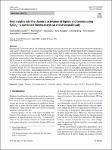Search
Author
- Guizani, Chamseddine (1)
- Markus, Dablander (1)
- Renaud, Lambiotte (1)
- Siipola, Virpi (1)
- next >
Subject
- K2CO3 chemical activation (1)
- QSAR models (1)
Date issued
- 2023 (2)
Has File(s)
- true (2)
Search Results
Pairs of similar compounds that only differ by a small structural modification but exhibit a large difference in their binding affinity for a given target are known as activity cliffs (ACs). It has been hypothesised that QSAR models struggle to predict ACs and that ACs thus form a major source of prediction error. However, the AC-prediction power of modern QSAR methods and its quantitative relationship to general QSAR-prediction performance is still underexplored. We systematically construct nine distinct QSAR models by combining three molecular representation methods (extended-connectivity fingerprints, physicochemical-descriptor vectors and graph isomorphism networks) with three regression techniques (random forests, k-nearest neighbours and multilayer perceptrons); we then use ea... |
Engineering of activated carbons (ACs) through chemical activation of organic precursors has been extensively studied for a wide variety of biopolymers, biomasses, wastes and other fossil-based precursors. Despite huge efforts to engineer evermore performant and sustainable ACs, “searching-for-the-best-recipe” type of studies are more the rule than the exception in the published literature. Emerging AC applications related to energy and gas storage require strict control of the AC properties and a better understanding of the fundamentals underlying their engineering. In this study, we provide new insights into the K2CO3 chemical activation of plant-based polyphenols—lignins and tannins—through careful thermoanalytical and structural analyses. We showed for the the first time that th... |


